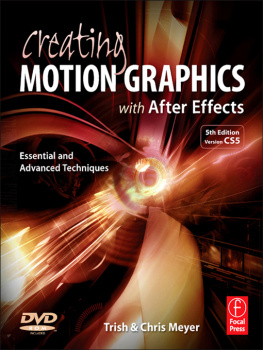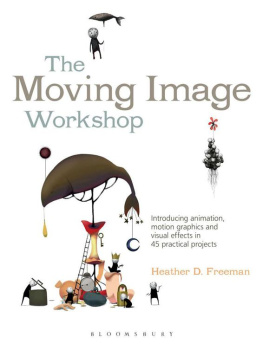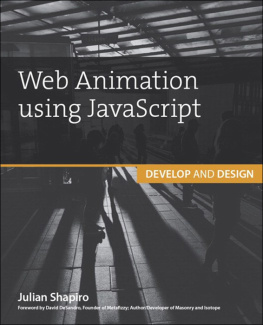
Advance praise for Frame-by-Frame Stop Motion
Toms extensive experience as a stop motion animator, combined with his knowledge of the field and his natural teaching ability, make this book a clear, well-organized, and empowering introduction to stop motion animation. This book will be an invaluable resource for student and teacher alike.
Steven Subotnick, animator, educator, and author of
Animation in the Home Digital Studio
In the digital age it pays to remember that innovative ideas can still be inspired using even the most basic techniques. This book is a timely reminder that a rewarding process depends as much on ingenuity as it does on facility.
Dave Borthwick, animation director, Bolex Brothers
A must-have book for any animators library. Frame-by-Frame is a reminder of all the magical possibilities animation has to offer and all you need is a camera and an idea.
Jim Capobianco, filmmaker, Leonardo
This book is a wonderfully inspiring, accessible and thorough guide to a number of techniques that have seldom been written about or charted before. It is an essential manual for any student, professional or creative person who has ideasand wants to be encouraged with a sense of I could do thatand wants to get their ideas out there. I just wish this book had been written when I was a student of animation (I still am, so I will buy it anyway).
Nick Park, Academy Award winner and creator of Wallace and Gromit
Frame-by-Frame Stop Motion
Frame-by-Frame Stop Motion
The Guide to Non-Traditional Animation Techniques
Tom Gasek

Focal Press is an imprint of Elsevier
225 Wyman Street, Waltham, MA 02451
The Boulevard, Langford Lane, Kidlington, Oxford, OX5 1GB, UK
2012 Elsevier Inc. All rights reserved.
No part of this publication may be reproduced or transmitted in any form or by any means, electronic or mechanical, including photocopying, recording, or any information storage and retrieval system, without permission in writing from the publisher. Details on how to seek permission, further information about the Publishers permissions policies and our arrangements with organizations such as the Copyright Clearance Center and the Copyright Licensing Agency, can be found at our website: www.elsevier.com/permissions.
This book and the individual contributions contained in it are protected under copyright by the Publisher (other than as may be noted herein).
Notices
Knowledge and best practice in this field are constantly changing. As new research and experience broaden our understanding, changes in research methods, professional practices, or medical treatment may become necessary.
Practitioners and researchers must always rely on their own experience and knowledge in evaluating and using any information, methods, compounds, or experiments described herein. In using such information or methods they should be mindful of their own safety and the safety of others, including parties for whom they have a professional responsibility.
To the fullest extent of the law, neither the Publisher nor the authors, contributors, or editors, assume any liability for any injury and/or damage to persons or property as a matter of products liability, negligence or otherwise, or from any use or operation of any methods, products, instructions, or ideas contained in the material herein.
Library of Congress Cataloging-in-Publication Data
Application submitted.
British Library Cataloguing-in-Publication Data
A catalogue record for this book is available from the British Library.
ISBN: 978-0-240-81728-6
For information on all Focal Press publications
visit our website at www.elsevierdirect.com
11 12 13 14 5 4 3 2 1
Printed in China

Dedication and Acknowledgments
As in any large endeavor, many people are always involved. Like filmmaking itself, a team effort is critical to the success of any book, and Frame-by-Frame Stop Motion is no exception. I have written this book from my own point of view and acknowledge that it is only one point of view. I was fortunate to have two friends and colleagues review each of my chapters and add their comments and observations. Many years ago, Bryan Papciak, Jeff Sias, and I used to work together in the stop-motion industry at a studio called Olive Jar in Boston. We came to appreciate our collective contributions to many projects, and it seemed natural to have them involved in this process. I am eternally grateful for their input. I am also grateful for the positive and encouraging attitude of my editor, Katy Spencer at Focal Press.
The critical elements to this text are the many contemporary artists and filmmakers that contributed comments and images to this study of alternative stop-motion techniques. This includes Terry Gilliam, Jan Svankmajer, PES, Blu, William Kentridge, Dave Borthwick, Nick Upton, Dave Sproxton and Aardman Animations, Jan Kounen, Caroline Leaf, Evan Spiradellis, Jim Blashfield, Joan Gratz, Joanna Priestly, Ken Murphy, Miki Cash, Eric Hanson, Tom Lowe, Yuval and Merav Nathan, Chris Church, Juan Pablo Zaramella, Jeff Sias, Bryan Papciak, Daniel Sousa, Eugene Mamut, Joe Lewis, Jamie Caliri, Adam Fisher, Monica Garrison, J. P. Crangle, The National Film Board of Canada, Lindsay Berkebile, Jordan Greenhalgh, Jason McLagan, Rachel Fisher, Marlee Coulter, Stevie Ward, Clare Kitson, Nick Park, Roxann Daniel, and the School of Film and Animation at The Rochester Institute of Technology. Many more artists and filmmakers are practicing these techniques than I was able to cite or interview. These frame-by-frame techniques are as varied as the artists who practice them, and I was able to touch on only a few approaches. I tried to incorporate principles and practices that are common to most of these techniques, but I am sure that I left out a few. My aim is to open up the door a bit wider to handmade animation approaches. These approaches have been evolving since technology continues to expand, and this makes these techniques as viable as ever. All one has to do is scan the web and see what is out there; suddenly you realize that this is a vast and potentially exciting area of filmmaking. The old saying what is old is new applies to this book, but again, technology has made these approaches to single-frame filmmaking much more accessible, and I hope many new filmmakers are able to explore this area of animation. The book can serve as a guide.
So I dedicate this book to all the new filmmakers and established filmmakers that want to expand their means of expression through frame-by-frame animation.
Drawn illustrations by Brian Larson.
Photographic illustrations by Tom Gasek and artists cited in each chapter.
Contents
Introduction
Why This Book?
Stop-motion animation has been a passion and calling of mine for 30 years. My undergraduate studies were in Design at the Rochester Institute of Technology (where I now teach), and animation came into my life quite by accident. In my last two years at RIT, a new teacher, Erik Timmerman, decided to start an animation course, the first at RIT. Having been raised on cartoons with a love from Rocky and Bullwinkle to Gumby, I felt compelled to take this course. Upon my graduation, two years later, I was on my way to Hollywood to collect a Student Academy Award along with my partner Malcolm Spaull for our stop-motion version of Lewis Carrolls
Next page













